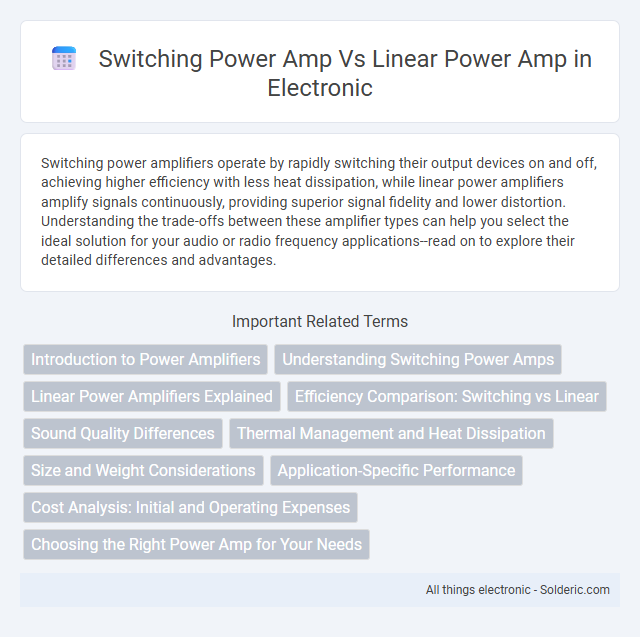Switching power amplifiers operate by rapidly switching their output devices on and off, achieving higher efficiency with less heat dissipation, while linear power amplifiers amplify signals continuously, providing superior signal fidelity and lower distortion. Understanding the trade-offs between these amplifier types can help you select the ideal solution for your audio or radio frequency applications--read on to explore their detailed differences and advantages.
Comparison Table
| Feature | Switching Power Amplifier | Linear Power Amplifier |
|---|---|---|
| Efficiency | High (typically 80-95%) | Low (typically 20-50%) |
| Heat Dissipation | Low heat generation | High heat generation |
| Sound Quality | Less linear, potential distortion | Highly linear, accurate sound reproduction |
| Size & Weight | Compact and lightweight | Larger and heavier |
| Cost | Generally lower due to efficiency | Typically higher due to complexity |
| Complexity | More complex switching circuits | Simpler circuit design |
| Applications | High-power, portable, and efficient audio systems | High-fidelity audio, studio equipment |
Introduction to Power Amplifiers
Power amplifiers are essential components in audio and communication systems, designed to increase signal strength for driving speakers or antennas. Switching power amplifiers operate with high efficiency by rapidly switching transistors on and off, minimizing power loss and heat generation. Linear power amplifiers provide high-fidelity amplification with minimal distortion but consume more power and generate greater heat compared to switching amplifiers.
Understanding Switching Power Amps
Switching power amplifiers operate by rapidly toggling transistors between on and off states, achieving high efficiency and minimal heat dissipation compared to linear power amps. This class-D amplification method is ideal for applications requiring compact size and energy-saving performance without compromising output power. Understanding switching power amps helps you optimize audio systems where efficiency and thermal management are critical.
Linear Power Amplifiers Explained
Linear power amplifiers operate by varying their output signal in direct proportion to the input, preserving signal integrity and minimizing distortion, which makes them ideal for high-fidelity audio and RF applications. Unlike switching power amplifiers that rapidly toggle on and off to improve efficiency, linear amps maintain a constant voltage level, resulting in higher linearity but lower energy efficiency. Understanding the trade-off between performance and power usage can help you choose the appropriate amplifier for your specific needs, such as broadcasting or high-precision instrumentation.
Efficiency Comparison: Switching vs Linear
Switching power amplifiers achieve efficiency rates typically between 80% and 95% by rapidly toggling transistors fully on or off, minimizing power loss as heat. Linear power amplifiers usually exhibit efficiencies around 20% to 30% due to their continuous operation in the active region, resulting in significant energy dissipation. High efficiency of switching amplifiers makes them preferable for applications requiring energy conservation and reduced thermal management.
Sound Quality Differences
Switching power amplifiers, also known as Class D amps, deliver higher efficiency and generate less heat but can introduce high-frequency switching noise, which may affect audio clarity and introduce distortion in sensitive listening environments. Linear power amplifiers, such as Class A or Class AB designs, provide a cleaner, more accurate sound reproduction with lower harmonic distortion, resulting in better fidelity and dynamic range, especially important for audiophiles and critical audio applications. Despite advancements in switching amplifier technology, purists often prefer linear amps for their superior sonic transparency and natural tonal characteristics.
Thermal Management and Heat Dissipation
Switching power amps, also known as Class D amplifiers, offer superior thermal management and heat dissipation compared to linear power amps due to their higher efficiency, typically exceeding 90%, which minimizes wasted energy as heat. Linear power amps, such as Class A or AB, generate significantly more heat because they operate with continuous current flow, requiring extensive heat sinks and cooling systems to maintain stable operation. Optimizing your audio setup with a switching power amp can reduce the need for bulky thermal management hardware, ensuring reliable performance in compact or heat-sensitive environments.
Size and Weight Considerations
Switching power amplifiers are significantly smaller and lighter than linear power amplifiers due to their higher efficiency and reduced heat dissipation requirements. The compact size of switching amps makes them ideal for portable and space-constrained applications, while linear amps often require bulky heat sinks and larger enclosures to manage thermal output. This size and weight advantage of switching power amplifiers contributes to easier integration in modern electronic devices and mobile systems.
Application-Specific Performance
Switching power amps deliver high efficiency and reduced heat dissipation, making them ideal for applications requiring compact size and energy conservation, such as wireless communication and battery-operated devices. Linear power amps provide superior linearity and low distortion, essential for high-fidelity audio and sensitive instrumentation where signal integrity is critical. Your choice depends on whether your application prioritizes efficiency and battery life or signal accuracy and audio quality.
Cost Analysis: Initial and Operating Expenses
Switching power amps generally have lower initial costs due to simpler, more efficient designs and smaller heat sinks, reducing material expenses. Operating expenses are also minimized since switching amps achieve higher efficiency, resulting in less power loss and lower cooling requirements, which in turn reduces electricity and maintenance costs. Your decision may depend on balancing these upfront savings with the potentially higher audio fidelity and heat dissipation costs associated with linear power amps.
Choosing the Right Power Amp for Your Needs
Switching power amps deliver higher efficiency, making them ideal for applications requiring minimal heat dissipation and longer battery life, such as portable audio devices and high-power systems. Linear power amps produce cleaner, more accurate audio signals with low distortion, preferred in professional studio environments or high-fidelity playback where sound quality is crucial. Understanding your usage scenario and performance priorities helps you choose the right power amp for your needs, balancing efficiency against audio purity.
switching power amp vs linear power amp Infographic

 solderic.com
solderic.com